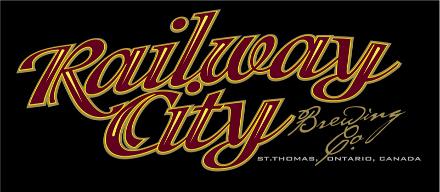

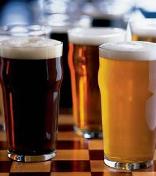
|
Railway City Brewing Company is proud to introduce our Dead Elephant Ale as our tribute to Jumbo the Elephant, who was tragically killed in a railroad accident in the late 1800’s in St.Thomas. Jumbo is featured throughout St.Thomas from the life size statue at the City’s west entrance, to the large wall murals adorning our downtown buildings. Jumbo was the prize attraction of the P.T. Barnum Circus that performed throughout North America. What a lot of people don’t realize is that during the early days, many circuses travelled by train, and thus many travelled to St.Thomas as part of their route. Many stories have been told about how Jumbo saved a small elephant from being hit by the oncoming unscheduled train, however most accurate stories reflect a simple accident like the story below. There have been many children’s books written and published throughout the world and many have cited St.Thomas as the place where Jumbo died. P.T. Barnum was a master marketer and many refer to the term of Jumbo sized items relating back to Jumbo the Elephant. In fact the name Jumbo was given to him by his London zookeepers which was a variation of one of two Swahili words: jambo (which means “hello”) or jumbe (which means “chief”) Either way, Jumbo’s name established the common word “Jumbo” as meaning large in size. We hope that when you raise your glass of Dead Elephant Ale, you will enjoy everything that Jumbo was and became. Life should be celebrated in every way and if possible enjoy it Jumbo sized! |


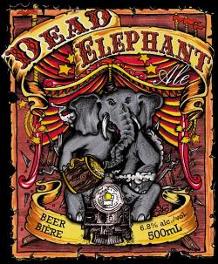
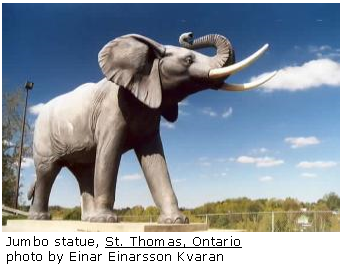
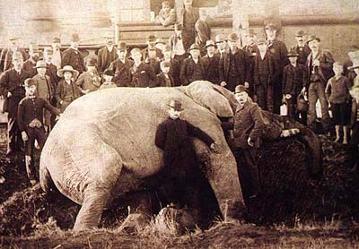
P. T. Barnum's Famous “Jumbo”By Charlie Duble. Bandwagon, Vol. 1, Jan-Feb, 1956, pp. 5-6.
The famous "JUMBO" advertised by the one and only P. T. Barnum as the "Lord of Beasts" was the largest elephant ever to be on exhibition, and for 15 years he had attracted nationwide attention at the London Zoological Gardens. Because of his great size and popularity the word "Jumbo" was formally adopted into the English language as a term for anything unusually large.
P. T. Barnum, the great American showman, rightly called "The Exhibition King" on one of his trips to Europe witnessed the thousands who daily thronged to Jumbo's court, and quickly realized the tremendous attraction of this elephant. Without further ado, Barnum arranged to purchase Jumbo from the Zoological Gardens for $10,000. Upon completion of the transaction the entire British public gushed forth their wholehearted indignation in furious uproar. Even the Prince of Wales publicly condemned the procedure and it was only by subterfuge that Barnum was finally able to spirit the big elephant on board the "Assyrian Monarch," and the acquisition of Jumbo had by now cost him an additional $20,000.
With bands playing and much bally-ho all arranged in advance by Barnum, "the master of bally-ho," Jumbo arrived in America on April 9, 1882. Here he immediately took up where he had left off and endeared himself to the American public both young and old. For the next three years he was exhibited by his circus owners in the United States and Canada. The reception tendered him in every city, town, and hamlet was tremendous. His presence alone meant thousands of dollars to the coffers of the Barnum & London Circus - (The Barnum & Bailey name was not used until 1888).
For his daily ration he ate the following: 200 pounds of hay, two bushels of oats, a barrel of potatoes, ten loaves of bread, two or more quarts of onions, and according to his keeper Matthew Scott, he relished an occasional keg of beer.
It was on the night of September 15, 1885, to a large audience in St. Thomas, Ontario, Canada, that Jumbo completed what was destined alas, to be his lost magnificent performance. He was escorted by his keeper, Scott, to the waiting circus cars, there to be loaded for the next stop on the itinerary. The circus trains had been backed into the only siding of a one track line, ready to receive and load all the circus equipment. To expedite the loading, a gap had been torn in the fence along the right of way, and a space had been left between the cars on the siding to permit access to the main track.
Jumbo's private car was some distance down the main line, and it was while walking to this that a shrill whistle signaled the approach of an oncoming freight train on the Grand Trunk railroad, on the very same track. The railroad employee whose job it was to flag down any advancing train while the show was being loaded had, on hearing that the big elephant was coming through the gap, left his post to get a better view. His carelessness was the cause of Jumbo's sad ending.
Hysterically, but too late, the flagman ran toward the swiftly approaching train, waving his red lantern. Brakes were speedily set, sparks flew from the locked wheels, but the downward grade had already given the onrushing train a tremendous impetus, allowing the brakes to have little effect in the short distance. Scott frantically turned Jumbo around, shouting, "Run Jumbo, run." The elephant responded with alacrity and raising his trunk high in the air commenced to retrace his steps to the opening which he had just passed.
Running wildly he had in the meantime passed the opening he sought by two full car lengths, before he realized his mistake. Turning around to retrace this precious distance to safety, he was met head on by the engine. The force of the impact was so great that the engine was derailed and a car following it was also. Jumbo's head was crushed between a box car and a flat car. In a lawsuit that followed, between the railroad and the circus, a settlement was reached out of court, whereby Barnum received $10,000 in cash and free use of that railroad, the Grand Trunk, for one year for transportation of the circus. Barnum claimed that the loss of Jumbo meant at least $100,000 at the gate. Many accounts have been published of the famous elephant, some with errors, and his height stated as much as 11 feet at times, however from accurate records preserved by the MUSEUM of NATURAL HISTORY, Jumbo was 10 feet, nine inches tall.
The famous elephant was mounted and displayed by the circus for a period of two years as a silent added attraction of what was once mighty and strong. Later Jumbo's skeleton was presented to the Museum of Natural History, where it may be seen to this day during visiting hours. The hide was reconstructed and stuffed, and can be seen at the Barnum Museum at Tufts College, Medford, Mass., where P. T. Barnum was on the board of directors. The writer has seen the mounted Jumbo on two occasions while in Medford with Downie Bros. Circus. Many thousands have looked on with wonderment.
Jumbo, king of elephants, was mourned far and wide. He was one of the few African elephants ever brought to America, and he was an animal whose reputation eclipsed that of any favorite that since has been presented to the public. |
|
Photo taken just shortly after the accident. In fact the train behind Jumbo was staged as the engine that hit Jumbo was damaged and derailed. The engine that was damaged was repaired and for many years featured an metal emblem on the front of the engine of Jumbo. |
|
Dead Elephant Ale—Label artwork was designed by Billie Janes, of Hardcore Tattoos in downtown St.Thomas. |
|
The design embodies a larger than life elephant riding the rails to his demise. Elements include a large circus tent, flags, banners, spikes and railway track flying apart. Make sure you Enjoy your Dead Elephant Ale, responsibly! |
